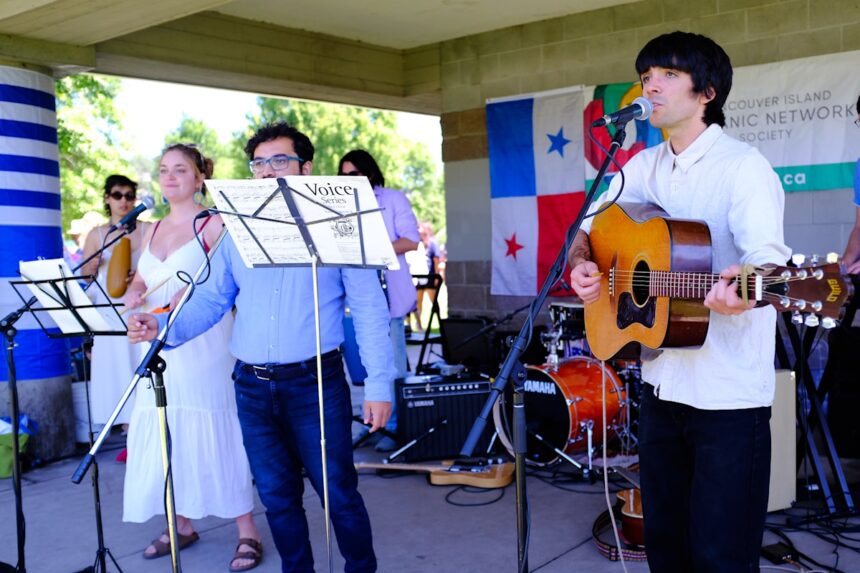Walking into the Pearkes Recreation Centre in Saanich last Saturday, I was immediately enveloped by the sounds of marimba, the scent of empanadas, and a sea of vibrant colors. Children with painted faces darted between booths draped in flags from across Latin America, while elders swayed to music that seemed to bridge the vast distance between Vancouver Island and countries thousands of kilometers away.
“This festival is about making a home away from home,” explained Maria Escobedo, one of the organizers of the Hispanic Cultural Festival Saanich 2024, as she adjusted a string of papel picado overhead. “For many of us who immigrated here, these cultural touchstones are lifelines to our identity.”
Now in its fifth year, the festival has grown from a modest gathering of a few dozen families to an event that drew over 2,000 attendees this year. The growth reflects the expanding Hispanic presence in Greater Victoria – according to Statistics Canada, the Spanish-speaking community in the region has increased by nearly 40% since 2016.
The festival showcased music and dance performances from Mexico, Guatemala, Colombia, Chile, and several other Latin American countries. On the main stage, the Alma de Mexico Dance Group performed a series of traditional folk dances, their wide skirts creating whirlwinds of color as they moved in perfect synchronicity. Nearby, the Chilean Cultural Society offered samples of empanadas de pino, while explaining the history of the dish to curious visitors.
For children born in Canada to Latin American parents, the festival offers something particularly meaningful. Twelve-year-old Sofia Mendoza, born and raised in Victoria to parents from El Salvador, helped at her family’s pupusa stand. “At school, I’m just Canadian. Here, I get to be both Canadian and Salvadoran,” she told me, her face brightening. “And my friends from school get to see this other part of who I am.”
Dr. Carmen Rodriguez, a cultural anthropologist at the University of Victoria who studies diaspora communities, sees these cultural festivals as crucial spaces for identity formation. “These events are not simply nostalgic recreations of homeland traditions,” she explained. “They’re dynamic spaces where new, hybrid cultural expressions emerge that reflect both the heritage culture and the Canadian context.”
The festival is also increasingly important for non-Hispanic residents of Saanich. Local teacher Derek Thompson brought his entire family. “We’ve been coming for three years now,” he said, as his five-year-old daughter had her face painted with a colorful calavera design. “It started as a way to expose our kids to different cultures, but it’s become something we genuinely love participating in. The food alone is worth the trip!”
That cultural exchange goes both ways. Many of the artisans’ booths featured fusion creations – traditional weaving techniques used to create products suited for Pacific Northwest weather, or ancestral recipes adapted to incorporate local Vancouver Island ingredients.
“We’re not just preserving culture in amber,” explained Javier Sanchez, who moved from Mexico to Victoria in 2011 and now runs a small business selling handcrafted items. “We’re living cultures that grow and adapt. My children are Canadian, but they’re also Mexican. The festival helps them understand that these identities don’t have to compete – they complement each other.”
The festival has also become an important economic opportunity for many small business owners in the Hispanic community. The Saanich Peninsula Chamber of Commerce estimates that last year’s festival generated approximately $45,000 in direct revenue for vendors and has a growing impact on the local economy.
Beyond the dancing, music, and food, the festival offered resources for newer immigrants, with booths providing information about healthcare access, language classes, and employment services. Volunteers from the Inter-Cultural Association of Greater Victoria were on hand to answer questions and connect newcomers with programs designed to ease their transition.
As evening approached and families continued to stream through the doors, I found myself watching three generations of a Nicaraguan family teaching a group of non-Hispanic festival-goers how to dance palo de mayo. The grandmother, who spoke little English, communicated entirely through gestures and rhythm, creating a moment of connection that transcended language barriers.
“This is why we do this,” said Escobedo, gesturing toward the impromptu dance lesson. “Culture is meant to be shared. When we invite others into our traditions, we all become richer for it.”
As the Hispanic population continues to grow in Greater Victoria, events like the Hispanic Cultural Festival Saanich represent more than just a celebration – they’re a testament to how communities can preserve their heritage while simultaneously building new connections in their adopted home.
For many attendees, the festival provides a rare opportunity to experience the full diversity of Hispanic cultures, which are often flattened into simplistic stereotypes. From the stark differences between Caribbean and Andean musical traditions to the distinct regional cuisines of Mexico alone, the event highlighted the rich tapestry that makes up Latin American heritage.
As I left the festival that evening, the sounds of cumbia still ringing in my ears, I carried with me a deeper appreciation for how cultural celebrations like these strengthen our communities – not by enforcing separation, but by creating spaces where differences can be celebrated and new connections forged.






